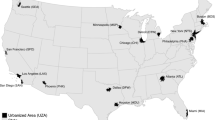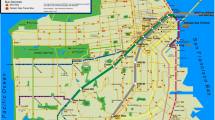Abstract
The issue of returns of scale in bus transit continues to be a subject of debate among transportation analysts. From a public policy perspective, returns to scale are relevant to many policy areas such as transit service pricing, cost allocation, productivity and organization of the industry. Empirical studies conducted during the past decade have generated conflicting results. Constant, decreasing and increasing returns to scale have all been reported.
This paper identifies the sources of these conflicting results: confusion regarding the concept of scale economies, variable definition, assumptions regarding the shape of the cost function, and certain characteristics of the data base. The paper also discusses the theoretical concept of scale economies, and an interpretation of the concept for bus transit is presented. It is concluded that recent studies which have utilized generalized cost functions more accurately represent the economic structure of bus transit, and provide a stronger basis for transit policy analysis.
Similar content being viewed by others
References
Bailey, E. E. and Friedlaender, A. F. (1982). “Market structure and multiproduct industries”, Journal of Economic Literature 22: 1004–1048.
Baumol, W. J. (1976). “Scale economies, average cost, and the profitability of marginal cost pricing”, in R. E. Grieson, ed., Public and Urban Economics. Lexington Books, Lexington, MA.
Beesley, M. E. (1973). Urban Transport: Studies in Economic Policy, London: Butterworth.
Berechmann, J. (1983). “Costs, economies of scale and factor substitution in bus transport. An analysis”, Journal of Transport Economics and Policy XVII (1): 7–24.
Berechman, J. and Giuliano, G. (1984). “Analysis of the cost structure of an urban bus transit property”, Transportation Research.
Boyd, J. H., Asher, N. J. and Wetzler, E. S. (1978). “Nontechnological innovation in urban transit, a comparison of some alternatives”, Journal of Urban Economics 5: 1–20.
Caves, D. W., Christensen, L. R. and Swanson, J. A. (1980). “Productivity in U.S. railroads, 1951–1974”, Bell Journal of Economics 11 (1): 166–181.
Cherwony, W. and Mundle, S. (1980). “Transit cost allocation model development”, ASCE Transportation Engineering Journal 106 (TE1): 31–42.
Chomitz, K. M. and Lave, C. A. (1981). Part-time Labor, Work Rules, and Transit Costs. Final report. D.O.T., Urban, MA Transportation Administration report No. CA-I 1–0018. Irvine, CA, University of California, Institute of Transportation Studies and School of Social Sciences, (NTIS No. PB 81–180556).
Fielding, G. J., Glauthier, R. E. and Lave, C. A. (1978). “Performance indicators for transit management”, Transportation 7 (4): 365–379.
Fielding, G. J., Brenner, M. E., de la Rocha, O., Babitsky, T. T. and Faust, K. (1984). Indicators and Peer Groups for Transit Performance Analysis. Final Report. D.O.T., Urban, MA, Transportation Administration report No. CA-11–0026–2. Irvine, CA: University of California, Irvine.
Fisher, P. and Viton, P. (1974). The Full Cost of Urban Transport. Part I: Economic Efficiency in Bus Operations: Preliminary Intermodal Comparisons and Policy Implications. Monogr. No. 19, Berkeley, CA, University of California, Institute of Urban and Regional Development, 174, (NTIS No. PB 248–145).
Foster, J. R. (1974). “The determinants of costs and the cost function of urban bus transit 1960–1970”, Doctoral Dissertation, Syracuse University, Dissertation Abstracts International 35: 1288-A.
Friedlaender, A. F. and Spady, R. H. (1981). Freight Transport Regulation. The MIT Press.
Fuss, M., McFadden, D. and Mundlak, T. (1978). “A survey of functional forms in the econometric analysis of production”, in M. Fuss and D. McFadden, eds., Production Economics. Amsterdam: North-Holland Publishing.
Giuliano, G. (1981). “The effect of environmental factors on the efficiency of public transit service”, Transit Planning and Management, Transportation Research Board pp. 11–16.
Gold, B. (1981). “Changing perspectives on size, scale, and returns: An interpretive survey”, Journal of Economic Literature 19: 5–33.
Griliches, Z. (1972). “Cost allocation in railroad regulation”, Bell Journal of Economics 3 (1): 26–41.
Harris, R. G. (1977). “Economies of traffic density in the rail freight industry”, Bell Journal of Economics 8 (2): 557–564.
Johnston, J. (1972). Econometric Methods. 2nd edn., New York: McGraw-Hill.
Kemp, M. A., Beesley, M. E. and McGillivray, R. G. (1981). “Bus costing information in short-range planning: Survey of principles and practice”, Transportation Research Record 799: 28–31.
Keeler, T. E. (1974). “Railroad costs, returns to scale and excess capacity”, The Review of Economics and Statistics 56 (2): 201–208.
Koshal, R. K. (1970). “Economies of scale in bus transport: Some Indian experience”, Journal of Transport Economics and Policy 4 (1): 29–36.
Koshal, R. K. (1972). “Economies of scale. II. Bus transport: Some United States experience”, Journal of Transport Economics and Policy 6 (2): 151–153.
Lee, N. and Steedman, I. (1970). “Economies of scale in bus transport. I. Some British municipal results”, Journal of Transport Economics and Policy 4 (1): 15–28.
McGillivray, R., Kemp, M. and Beesley, M. (1980). Urban Bus Transit Costing. Working paper No. 1200–72–1, Washington, D.C.: Urban Institute.
Manski, C. F. (1979). “The zero elasticity rule for pricing a government service: A summary of findings”, Bell Journal of Economics 10 (1): 211–223.
Meyer, J. R. and Gomez-Ibanez, J. A. (1975). Measurement and Analysis of Productivity in Transportation Industries. Discussion paper D75–6, Cambridge, MA, Harvard University, Dept. of City and Regional Planning.
Miller, D. R. (1970). “Differences among cities, differences among firms, and costs of urban bus transport”, Journal of Industrial Economics 19 (1): 22–32.
Mohring, H. (1972). “The peak-load problem with increasing returns and pricing constraints”, American Economics Review 62: 591–604.
Mohring, H. (1976). Transportation Economics. Ballinger.
Nelson, G. R. (1972). An Econometric Model of Urban Bus Transit Operations. Paper P-863, Arlington, VA, Institute for Defense Analysis.
Oram, R. L. (1979). “Peak-period supplements: The contemporary economics of urban bus transport in the U.K. and U.S.A.”, Progress in Planning 2 (2): 81–154.
Oum, T. H. (1979). “Derived demand for freight transportation and inter-modal competition in Canada”, Journal of Transport Economics and Policy 13 (2): 149–168.
Pozdena, R. J. (1976). A Methodology for Selecting Urban Transportation Projects. Monogr. No. 22, Berkeley, CA, University of California, Institute of Urban and Regional Development.
Train, K. (1977). “Optimal transit prices under increasing returns to scale and loss constraint”, Journal of Transport Economics and Policy 11 (2): 185–194.
Veatch, J. F. (1973). Cost and Demand for Urban Bus Transit. Unpublished doctoral dissertation, University of Illinois, available from Xerox University Microfilms as No. 74-5723.
Viton, P. A. (1981). “A translog cost function for urban bus transit”, Journal of Industrial Economics 29 (3): 287–304.
Wabe, J. S. and Coles, O. B. (1975). “The short and long-run cost of bus transport in urban areas”, Journal of Transport Economics and Policy 9 (2): 127–140.
Williams, M. L. and Dalal, A. (1981). “Estimation of the elasticities of factor substitution in urban bus transportation: A cost function approach”, Journal of Regional Science 21 (2): 263–275.
Williams, M. L. and Hall, C. (1981). “Returns to scale in the United States intercity bus industry”, Regional Science and Urban Economics 11: 573–584.
Wilson, H. G. (1977). “The cost of operating buses in U.S. cities”, Journal of Transport Economics and Policy 11 (1): 68–91.
Author information
Authors and Affiliations
Rights and permissions
About this article
Cite this article
Berechman, J., Giuliano, G. Economies of scale in bus transit: A review of concepts and evidence. Transportation 12, 313–332 (1985). https://doi.org/10.1007/BF00165470
Issue Date:
DOI: https://doi.org/10.1007/BF00165470




